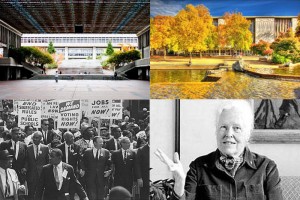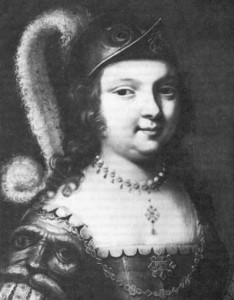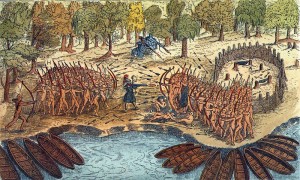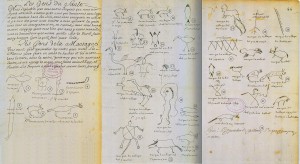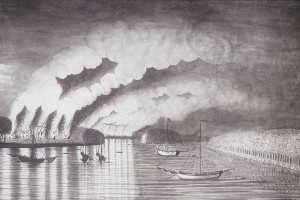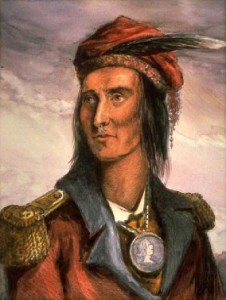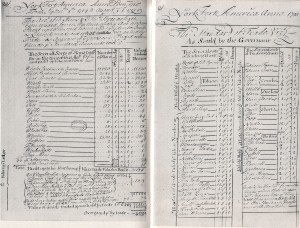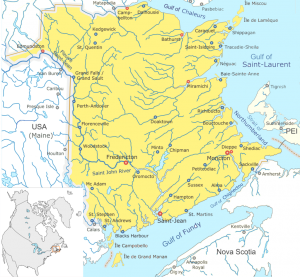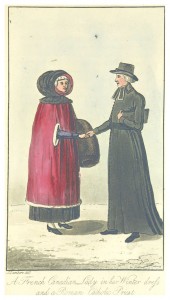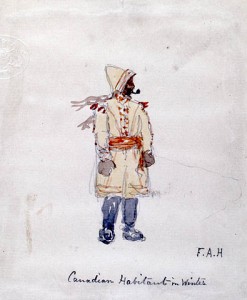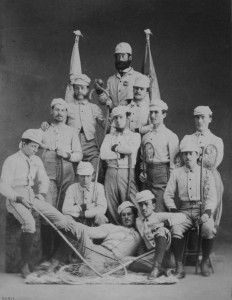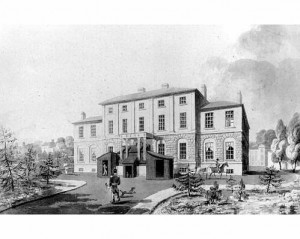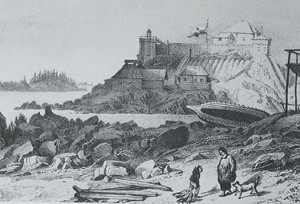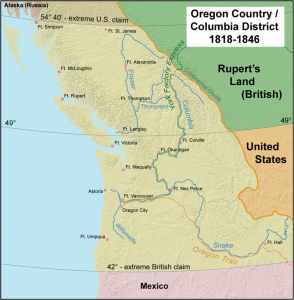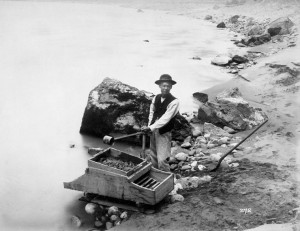This glossary is a summary of all key terms that appear at the end of each chapter.
Glossary
abolition (ch 7): Refers to the abolition of the institution of slavery. In Britain a single piece of legislation resulted in the abolition of slavery in 1834. Abolition in Upper Canada was initiated by John Graves Simcoe in 1793.
aboriginal title (ch 7): Aboriginal ownership of land and/or territory and/or other material resources.
absentee landlords (ch 7): Also called proprietors, the main landowners on Prince Edward Island whose land was allocated to them in a lottery held in London in 1767. Few of them visited the island and few attended to the responsibilities they were given as landlords. Most, however, attempted to charge significant rents to their tenant farmers in the colony. See also escheat.
Acadian Expulsion (ch 6): The removal of Acadians and other francophones from Île Royale after 1745,and accelerating after 1755 as the British forcibly removed the larger portion of the colonist population. In French it is called Le Grand Dérangement.
Act of Proclamation (1763) (ch 7): Also called the Proclamation Act, the legislation that created the Province of Quebec and recognized Aboriginal title in the west. The Act angered American settlers because it hampered westward movement into the Ohio Valley.
Act of Union, 1840-41 (ch 11): The constitutional arrangement for the Canadas that replaced the Constitutional Act of 1791. Its main features were union of Lower and Upper Canada, creating one colony and one colonial government and an identical number of assembly seats for both partner colonies, with an eye to subsuming the French-Catholic community. The Province of Canada would retain some regional divisions and the old colonies perpetuated their separate identities as Canada East and Canada West.
African-American slaves (ch 7): Chattel slaves, principally from Africa, who worked primarily on plantation economies. Slavery occurred throughout North America in both European and Aboriginal communities. Some African-American (as opposed to African-Caribbean) slaves were later freed (see freedmen) pending on their role in the American Revolution.
agricultural revolution (ch 2): In the context of the Archaic era, the development of the first farming societies in the Americas.
Anglican Church (ch 3): See Church of England.
anglicization (ch 7): >British policy of replacing French culture — language, customs, laws, and Catholic religion — with those of Anglican/Protestant Britain.
Annapolis Royal (ch 6): British name for Port Royal.
anthropogenic (ch 2): Made or modified by humans.
archaeological record (ch 2): Any evidence regarding past societies and civilizations (Aboriginal or otherwise) that derives from the use of archaeological techniques and methods.
Archaic period (ch 2): The era 10,000 – 3,000 years BPE.
Archaic Woodland (ch 2): The era described by archaeologists and anthropologists as roughly 1,000 BCE – 1,000 CE.
archives (ch 1): Collections of original documents, including print-based objects like personal letters, official reports, journals, newspapers, maps, government papers, and so on. Archival collections may also include photographs, music (in a variety of forms), and textiles. Technically, your own collection of original materials is an archive but, for the purposes of history courses, archives are official repositories that may or may not be open to the public.
aristocracy (ch 3): A privileged social class whose power is usually derived from birth, heredity, and almost exclusive ownership of land, close connections with the clergy and government, and with the Crown. As a form of government, a system in which a small and wealthy elite holds power to the exclusion of others.
Assiniboia (ch 8): Synonymous with Selkirk Colony or Red River Colony. The Treaty of 1818 divided it at the 49th parallel, thereby reducing Assiniboia significantly. After Confederation and the creation of the province of Manitoba, the name was applied to a new regional administrative unit in the North West Territories. This District of Assiniboia ran horizontally across the southern Canadian Prairies and was bounded on the east by Manitoba, on the south by the 49th parallel and the United States, on the west by the District of Alberta, and on the north by the District of Saskatchewan.
Attawandaron (ch 5): An Iroquoian people located in the contact and post-contact periods in what is now southwestern Ontario. Also known as the Neutral.
Aztecs (ch 2): A Mesoamerican civilization and polity that collapsed in the early 16th century. The Aztecs developed many agricultural techniques and administrative customs that influenced societies around the Gulf of Mexico. Their influence may have spread up the Mississippi River as well.
baby boom generation (ch 1): Individuals born in the post-Depression era of ca.1939 to 1964.
backward linkages (ch 9): Describes economic inputs (often infrastructure) that support the production of the principal staple. In the case of the fur trade, backward linkages include warehouses, docks, and fur trade posts. In the case of the wheat economy, they linkages include silos, means of transporting grain, seed, and farm implements. Compare withforward linkages.
Battle of Sainte-Foy (ch 6): Battle on April 28, 1760, near the citadel of Quebec with the French/Canadien forces attacking the British. General Murray repeated many of the errors of Montcalm only months before. The British survived (having suffered more than a thousand casualties) by hunkering in the fortress until British naval reinforcements arrived.
Battle of Seven Oaks ( ch 8): On June 19, 1816, two parties made up of HBC employees (including Governor Robert Semple) and Red River settlers against a party of Métis, Canadiens, and Aboriginals connected with the NWC. This was a violent chapter in the Pemmican War and was provoked by a food shortage and the HBC’s consequent attempt to control the movement and sale of pemmican.
Before the Common Era (BCE) (ch 2): This term, along with CE, align exactly with the Christian dating system, dividing time approximately 2,000 years ago.
Before the Present Era (BPE) (ch 2): a dating system based on the use of radiocarbon-dating, which uses January 1, 1950, as its baseline. Therefore, 10,000 years BPE equals 10,000 years before New Year’s Day, 1950.
benevolent societies (ch 10): Also called a “friendly society” or “mutual society.” Benevolent societies are a kind of cooperative organization in which the members subscribe money as insurance against illness, injury, widowhood, etc. Benevolent societies still exist but many have been supplanted by insurance companies and state welfare systems. See voluntary associations.
Bering land bridge (ch 2): The land form, made mostly of land that was exposed by falling sea levels, that connected Eurasia and North America between Siberia and Alaska 50,000 to 10,000 years BPE. A possible route for human migration from Asia to the Americas. Also called Beringia.
Beringia (ch 2): The open plain of land and glaciers that once filled the current gap between Siberia and Alaska.
Black Death (ch 3): Also called simply “the plague,” a highly contagious disease reckoned to have reduced the total human population by 25% and as much as half of Europe’s population in the 14th century. In its aftermath there was social and religious upheaval from China to the British Isles.
Blackfoot Confederacy (ch 5): Also known as the Niitsitapi, and alliance centred in the western Plains, in territory that extended from what is now southern Alberta into Montana; consisting of the Piikuni (Piegan), Siksika (Blackfoot), Kanai (Blood), Tsuu T’ina (Sarcee), and A’aninin (Gros Ventre).
bourgeois, bourgeoisie (ch 6): Originally someone who lived in the town (French: bourg; German: burg; English: borough), typically associated with merchants, professionals, etc. By the 18th century the bourgeoisie emerged as a distinct social class, a “middle class.”
brewing (ch 7): <The production of beer and the distilling of whisky, this was a means of adding value to surplus grain being grown in Upper and Lower Canada beginning in the 1780s. John Molson of Montreal was an early participant in brewing and, like many Canadians who followed in his footsteps in the liquor production trade, amassed a great fortune.
British North America (BNA) (ch 7): Term used intermittently after 1783 to describe the colonies left to Britain after the Revolution. Initially these included Newfoundland, the Province of Quebec, Prince Edward Island, and Nova Scotia. Subsequently the list would increase to include new colonies (Cape Breton Island and New Brunswick), a partitioned colony (Upper and Lower Canada), and in very general terms Rupert’s Land (which was not administered by a Crown delegate). Vancouver Island and British Columbia would also be regarded as part of British North America before Confederation.
buffalo jumps (ch 2): Sites on the plains associated with highly coordinated bison hunts conducted by Aboriginal communities.
Bungee (ch 8): Dialect that arose around the English-speaking settlements of Red River, layering elements of Anishinaabe/Ojibwa atop a substantial foundation of English and Gaelic to create what linguists call a creole.
Cahokia (ch 2): Thought to be the largest of the Mississippian towns/cities. Located near present-day St. Louis, it is believed to have crested around 1050 and collapsed around 1350.
Cajuns (ch 4): Francophone settlers in Louisiana descended mostly from Acadiens.
capital, capitalism, capitalists (ch 9): Capital is the portable wealth that can be applied to the economy in the form of investment. Prior to capitalism, wealth was manifest almost entirely in land and agricultural production. Investment was, in effect, reinvestment of output. Outsiders did not generally invest their wealth in the farms of others, certainly not in the pre-modern, feudal era. The mercantile era created a merchant class with excess capital (money, wealth) which was stored, invested, and made available for borrowing for investment. Capitalism is the system in which the means of production (farms, factories, etc.) are privately owned and capable of being bought and sold. It generally depends on wage labour. Capitalism is, too, a system of social relations based on the right of the individual to move capital to wherever it will generate the greatest benefits. A capitalist is someone who works within the capitalist system, whose wealth is based not on inherited and immovable property but on the ability to move wealth from one investment to another.
Cariboo Wagon Road (ch 13): Constructed from 1860 to 1885 to connect the Lower Mainland of British Columbia with the Cariboo goldfields. The original 1860-63 road ran from Port Douglas at the north end of Harrison Lake via Lillooet to Clinton and thence north across the Cariboo Plateau to Alexandria. An amended version in 1865 connected Yale to Ashcroft and then Clinton and the older road, having passed through the Fraser Canyon.
cayoosh, cayuse (ch 5): Regional words for “horse” in the Cordillera and western Plains. Derived from the Cayuse First Nation, who were responsible for significant advances in breeding in the 18th century.
censitaires (ch 4): Also known as habitants; the rent-paying tenants of the seigneurs. The rent is known as the cens.
Charlottetown Conference (ch 14): Convened by the leaders of New Brunswick, Prince Edward Island, and Nova Scotia for the purpose of discussing Maritime Union, the 1-9 September meeting agenda was expanded to include discussion of a union that would include the Province of Canada. Laid the groundwork for the Quebec Conference.
Chartists (ch 11): A movement for political reform in Britain during the 1830s, the supporters of the People’s Charter of 1838 – the Chartists – called for universal adult male suffrage, equitable constituencies, and other innovations which would radically broaden British democracy.
chattel slavery (ch 3): Ownership of a human being as a piece of property.
Chateau Clique (ch 7): A highly influential cadre of economic and social leaders who fashioned themselves politically as the British (or Tory) Party in Lower Canada. Their numbers included prominent merchants like James McGill and John Molson. Their agenda included assimilation of the French Catholic population and perpetuating a hierarchical social and political order.
Chemin du Roy (ch 6): The “King’s Road,” built in the 1730s; a major infrastructure project in its time. One of the longest continuous roads in North America, it connected seigneuries on the north shore of the St. Lawrence.
Chesapeake Affair (ch 7): During the Napoleonic Wars, a British attempt to reduce American shipping to France by means of capturing US shipping and impressing (forcing sailors) into the British Navy. In 1807 the USS Chesapeake, a warship, was bombarded and captured by the HMS Leopard; four sailors were seized and tried for desertion from the British Navy, one of whom was subsequently hanged. The Americans regarded this as an act of aggression and it fomented war fever in some quarters. See War Hawks.
chiefdom (ch 2): A form of organization based on a hierarchy of chiefs that followed the leader of the most important group.
Chilcotin War (ch 13): Also referred to as the Chilcotin Massacre, Chilcotin Uprising, and Bute Inlet Massacre. Occurred in 1864 when Tsilqot’in people asserted their control of their ancestral territory by murdering several members of a road-building crew and some colonists. The colonial authorities responded with a fruitless and expensive campaign that only ended when several of the Tsilqot’in leaders presented themselves for negotiations and were summarily arrested and subsequently hanged.
Chinatown (ch 10): Urban areas dedicated to the housing and businesses of Chinese immigrants and their families. Some Chinatowns appeared spontaneously and were built by the Chinese community; others were imposed by the dominant Euro-Canadian regime as a means of containing the Chinese population.
Chinook, chinuk wawa (ch 5): A trade dialect developed on the west coast comprising elements from several Aboriginal languages and subsequently adopting words from various European languages.
Church of England (ch 3): Also known as the Anglican Church, the state church in England established under Henry VIII in opposition to Roman Catholicism.
Church Missionary Society (CMS) (ch 13): Established in London, England, in 1799 the CMS began sending Anglican missionaries to Rupert’s Land in the 1820s. In 1857 William Duncan was dispatched to the northwest coast on behalf of the CMS.
civic buildings (ch 10): City halls, local jails, and courthouses are the most common “civic buildings” in the 19th century. Art galleries and museums – as public facilities – appear later. The erection of impressive civic buildings was a statement of civic pride, a means of promoting the community, and a statement regarding the growing power of municipalities.
civil rights movement (ch 1): In the United States, a movement principally in support of improved legal and civil rights for African-Americans. The movement is regarded as running from 1954 to 1968. It produced other movements associated with demands for rights for other groups that had historically faced prejudice and systemic marginalization.
civil service (ch 10): Employees of the state/colonies/municipalities. Includes surveyors, land officers, postmasters, and a few other positions in the 19th century. The number and types of civil servants expanded with the size of the state in mid-century.
Civil War (ch 9): The war between the southern and northern American states from 1861-1865. Seven southern slave states seceded from the Union and formed the Confederate States of America. The continuance of slavery and “states rights” were the key catalysts to the crisis. The number of war dead totalled more than 100,000, and at the end of the war the United States had the largest standing army on Earth.
class consciousness (ch 10): Awareness of one’s socio-economic status (or “class”) and how it (a) creates and limits opportunities, and (b) is experienced by others as well and constitutes as a set of common interests.
Clear Grits (ch 11): Reformers in Canada West who coalesced in 1850 behind a platform of universal adult male suffrage, and attacks on privilege. Principally rural at first, it became more urban under the leadership of George Brown in the late 1850s. Its founders called for men who were morally incorruptible, “all sand and no dirt, clear grit all the way through.” The Clear Grits joined with the Reformers and subsequently became the Liberal Party.
clearances (ch 8): The consolidation of feudal lands to enable the building of greater sheep flocks and thus feed the ravenous woolen industry in industrializing Britain. The Highland Clearances resulted in the displacement of large numbers of Scots, as did the Lowland Clearances, contributing to a massive out-migration in the 18th and 19th centuries.
Clergy Reserves (ch 7): Created by the Constitutional Act (1791), land parcels set aside (one-seventh of all public lands) in Upper Canada for the use of the Church of England (a.k.a. Anglican Church). There were smaller Clergy Reserves in Lower Canada as well.
Clovis (ch 2): Named for the archaeological site in New Mexico where it was first identified, the Clovis tradition is identifiable by the kinds of projectile heads it produced.
coastal migration theory (ch 2): An alternative to the Bering land bridge theory, which posits that the first human arrivals in the Americas arrived by sea, following the arc of the north Pacific icefield and skirting Beringia.
Code Noir (ch 4): Introduced under Louis XIV in 1685, the Code Noir established the ground rules for slavery in the French colonies. This included a prohibition of any religion other than Catholicism, the range of discipline permissible, and the conditions required for manumission (freeing of slaves).
codexes (codices) (ch 2): Scrolls written by Aztec and/or Mayan authors and scribes from the period both before and after the arrival of Europeans.
coffin ships (ch 9): Lumber boats that carried immigrants from Ireland to Canada in the 1830s. Many died during this trip as hygiene and overcrowded conditions aboard the boats were atrocious.
collectivities (ch 1): Groups of people who identify as part of a social body that may or may not correspond to a political unit. For example, First Nations peoples may identify collectively as First Nations, as opposed to (or perhaps in addition to) their identity as Cree or Mi’kmaq. French Canadian identity very often exists independent of (and sometimes in contrast to) a larger bicultural Canadian identity.
Columbian Exchange (ch 5): The traffic of goods, ideas, materiel, foodstuffs, technology, knowledge, and bacteria between Europe and Africa (on the one hand) and the Americas (on the other).
Columbia Express (ch 8): Route connecting York Factory to the mouth of the Columbia River by combining the assets and knowledge of the HBC. Also called the York Factory Express.
Common Era (CE) (ch 2): This term, along with BCE, aligns exactly with the Christian dating system, dividing time approximately 2,000 years ago.
<common law (ch 7): British code of laws dealing with property, contracts, and other civil matters.
Communauté des habitants (ch 4): Also known as the “Compagnie des habitants”; it worked in conjunction with the Compagnie des Cent-Associés in an arrangement that sublet the Cent-Associés’ monopoly to residents in the colony of Canada.
Compagnie des Cent-Associés (ch 4): The Company of One Hundred Associates (sometimes called the Company of New France or Compagnie de la Nouvelle France) was chartered in 1627 to operate the fur trade in Canada and Acadia and establish settlements. It followed two earlier chartered efforts, the Compagnie des Marchands and the Compagnie de Montmorency. The Compagnie des Cent-Associés ceased operating in 1663.
company store, company towns (ch 10): Many 19th and 20th century resource-extraction and construction industries were situated outside of established communities; under those circumstances a great many provided housing, supplies, groceries, work clothes, fuel, churches, and any number of other services so as to attract, retain, and (when necessary) discipline their workforce.
conquistadore (ch 3): Term used by the Spanish and Portuguese, meaning conqueror. Covers the military and clergy leaders of the Iberian invasions of the Americas.
Constitutional Act (1791)(ch 7): The legislation that created two colonies out of what was left of the Province of Quebec after the Treaty of Paris, 1783: Upper and Lower Canada. In Upper Canada the British common law was applied while the Coutume de Paris survived in Lower Canada. Both colonies received their own administrative structures.
contact (ch 2): The first documented encounter between Aboriginal peoples and Europeans. This is a movable date because first encounters occur in different regions at different times. The contact era for some Arctic peoples, for example, only began in the 20th century.
coparcenary (ch 6): A system of joint/shared inheritance of property.
Corn Laws (ch 9): Regulations governing the import and export of grain in Britain. A system of tariffs that benefited colonial and domestic producers and disadvantaged foreign producers in the British marketplace.
cottage industry (ch 10): A manufacturing process in which all or component parts of a product are assembled in a worker’s home. In the late 18th and early 19th centuries this was particularly associated with textile and clothing production.
Council of Assiniboia (ch 14): An unelected council created by the Hudson’s Bay Company in 1835 for the administration of Rupert’s Land.
counting coup (ch 2): The practice, common among many Aboriginal cultures, of attacking rival groups with the objective of inflicting injury but not necessarily fatality and to thereby acquire status commensurate with the humiliation meted out to the foe.
coureurs de bois (ch 4): In English, known as “runners of the woods.” The first coureurs de bois were young men dispatched by Champlain to reside among the Wendat, learn the Wyandot language, and develop an understanding of local trade protocols. Subsequently the coureurs were more likely to be independent or semi-independent traders seeking Aboriginal sources of furs across the interior of North America.
Coutume de Paris (ch 7): A code of civil law developed in and for Paris and extended to New France. Addressed land ownership and use, family relations, and inheritance.
Crimean War (ch 9): A multinational conflict centred on the Crimean Peninsula and the city of Sevastopol on the Black Sea. The war pitted Britain, France, and Turkey (the Ottoman Empire) against Russia. Noteworthy of the magnitude of deaths (roughly half a million) and the beginnings of the military field hospital (under Florence Nightingale) which produced important innovations in battlefield medicine.
crude birth rate (CBR) (ch 10): The number of births per 1000 population.
crude death rate (CDR) (ch 10): The number of deaths per 1000 population.
cullers (ch 9): Codfish buyers in Newfoundland ports, especially St. John’s.
decapitation thesis (ch 7): Historical theory that explains the apparent loss of Canadien leadership in the colony after the Conquest as the result of an exodus of leading commercial, administrative, and social figures to France.
democracy (ch 9): A form of government translated roughly from its Greek roots as “rule by the people.” The complicating factor is that “the people” is a slippery concept that is historically contextualized, and the extent of “rule” is also negotiable. Democracy was long associated with cities and towns, but not with nation states or empires, over which monarchies and oligarchies ruled. The emergence of representative democracy at a national level in the late 18th century – first in the United States, then in France – constituted a revolutionary change in organizing “the people’s” voice. In British North America, legislative assemblies might be elected but they did not rule, not until the 1840s. The majority of adults were “enfranchised” or legally able to participate in a democratic election only in the 20th century. It is still the case, of course, that people under the age of 18 years are not able to participate in democracy, so the vote is not “universal” by any stretch.
demographic historians (ch 1): Historians of population trends and mechanisms.
dependent population (ch 10): The share of population under the age of 15 years and over the age of 60 or 65. Clearly the notion of “elderly” dependant varies over time depending on life expectancies and population health generally.
diffusion (ch 2): The transmission of ideas, practices, or beliefs from one society to another.
disease vectors (ch 5): Viruses and bacteria transferred from one living host to another. Examples include droplets (like those produced in coughing or sneezing), parasites (like fleas or mosquitos), food, animal bites, and sexual intercourse. May also refer to the territory covered by a disease as it moves through a geographical area.
divine right of kings (ch 3): A doctrine based on the belief that the monarch’s power is derived directly from God and not from worldly authorities like a legislature, a council of nobles, or even the Vatican.
division of labour (ch 10): In a system of production, the isolation of certain tasks that are assigned to individuals working cooperatively to generate a certain product. In shoe production, for example, one person may be responsible for the uppers and someone else for the soles and a third for stitching them together.
Dorset (ch 8): The Paleo-Eskimo culture that existed in the Canadian Arctic from about 500 BCE – 1500 CE. Succeeded by the Inuit Culture.
double majority (ch 14): In the Province of Canada an attempt to break the gridlock under the 1840 constitution by means of multiple majorities: a majority in the 84-seat Assembly was required along with majorities in the Canada West and the Canada East segments of the Assembly (42-seats each) for a bill to pass into law.
double shuffle (ch 14): It was the practice under the 1840 constitution that new, incoming cabinet minsters in a government were obliged to resign their seat in parliament and seek re-election in a by-election. The idea behind this was that electors had a right to acknowledge and approve the change of status in their representative. In 1858 John A. Macdonald took advantage of this rule to vote out George Brown’s temporarily depleted government and then he merely moved his own ministers around – twice – so as to avoid having to go to by-elections. This cabinet “shuffle” thus became a “double shuffle.”
Douglas Treaties (ch 13): Also known as the Fort Victoria Treaties, these are fourteen agreements between the Colony of Vancouver Island (under the leadership of James Douglas) and Aboriginal communities.
Durham Report (ch 11): The Report on the Affairs of British North America of 1839 was the product of Lord Durham’s investigation in 1838 into the causes of the crisis in Canadian politics.
East India Company (ch 6): Established in 1600, the largest of Britain’s chartered trade monopolies. It dominated trade and was an instrument of British imperialism in Asia and was the model on which the Hudson’s Bay Company was based.
Edict of Nantes (ch 3): A statement of relative religious tolerance in 1598 that brought an end to the Wars of Religion in France and extended civil rights to Protestants (Huguenots).
Embargo Act (1807) (ch 7): In an attempt to force British and French respect for American shipping, federal legislation that was passed in Washington that effectively closed off all exports to foreign ports. The objective was to starve the importing nations of American goods and thus oblige them to cease preying on American shipping. It was repealed in 1809.
Empire of the St. Lawrence (ch 9): A phrase coined by historian Donald Creighton in the 1930s, it refers to the economic and political influence of Quebec and Montreal merchants and colonial governments over a region that extended, at its peak, across the whole of North America to the Pacific Ocean.
English Reformation (ch 3): Term used to describe several events connected to the English break with Catholic Rome under Henry VIII.
environmental history (ch 1): Charts the history of human interaction with natural and human-made settings. The environment may be a pristine one or an urban context. In some cases it is a study of how human activity impacts the environment (and vice versa); in others it studies the idea of the environment and how that concept changes over time.
environmentalism (ch 1): A philosophical interpretation of human interactions with the environment. May also refer to an activist movement and critique regarding the negative impacts of those interactions.
escheat (ch 7): A movement to force unimproved lands on Prince Edward Island back into the hands of the Crown. The Escheat Party made the land issue the dominant one in the colony in the 19th century.
established church (ch 11): When a state or nation has a single official institutionalized religion, it is referred to as the “established church.” In the case of France prior to the Revolution and New France prior to the Conquest it was unquestionably the Catholic Church; in Britain and its colonies, it was the Anglican Church (or Church of England). Post-Conquest attempts to impose the Anglican Church on the Canadas as the established church failed.
ethnohistory <(ch 1)A branch of academic studies that bridges anthropological and historical approaches, ethnohistory is principally concerned with non-European societies.
exotic diseases (ch 2): Infectious and highly contagious viruses introduced in the proto-contact and contact eras. Aboriginal people had little in the way of natural immunities to diseases they had never before encountered.
extended family (ch 9): Generally refers to three generations or more of one family. Another form, the consanguineal family, includes adult siblings.
Family Compact (ch 7): >An association of leading individuals and families in Upper Canada devoted to the suppression of republican tendencies in the colony and perpetuating an oligarchy in government. <
Famine Irish (ch 10): Emigrants from Ireland who fled the Great Famine of 1845-52.
Father Le Loutre’s War (ch 6): (1749-1755) Also called the Mi’kmaq (or Micmac) War, a conflict that pitted the Mi’kmaq and some of the Acadian communities against the British and New England interests in Nova Scotia.
Father Rale’s War (ch 6): (1722-1725) Known by several other names as well, a conflict provoked by New England expansion into unceded Wabanaki territory in what is now Maine and New Brunswick. The French were allied with the Wabanaki against the British and New England forces.
feminism (ch 1): An analysis of power relations that posits the existence of systemic barriers to equality between humans based on sexual identity. Feminism calls for a program of political and social action aimed at improving the conditions of females.
feudalism (ch 6): An economic and landholding system of social, legal, and military customs based on notions of mutual responsibility. Land ownership was typically by a manorial elite for which a peasantry laboured. The aristocratic landowners, in turn, owed labour to the higher nobility, including the king.
“Fifty-four Forty or fight!” (ch 13): Slogan coined in 1844 or 1845 by American expansionists eager to claim the whole of the Oregon Territory to the Alaska Panhandle (54°40’N).
filles du roi (ch 4): In English, known as “the king’s daughters.” Between 1663 and about 1673, this cohort of women (mostly young and many orphans) was recruited by the Crown’s agents (mostly in Paris) for settlement in Canada. Their passage was paid for by the king and they were provided with a dowry as an incentive to marriage.
Foresters (ch 10): The Ancient Order of Foresters (AOF), a benevolent society founded in England with branches globally and a focus on members’ insurance.
Fort Astoria (ch 8): Established at the mouth of the Columbia River in 1811 by John Jacob Astor’sPacific Fur Company, Astoria was the first American position on the northwest coast. It was soon thereafter sold to the North-West Company.
Fort Beausejour (ch 4): Built by the French in 1751 on the Chignecto Isthmus, which connects modern New Brunswick to Nova Scotia. This was an important land corridor connecting the Fortress of Louisbourg with Acadian settlements and Canada. The fort was also intended to support Mi’kmaq allies during war. Captured by the British in 1755, the name was changed to Fort Cumberland.
Fort Caroline (ch 3): Reckoned to be the oldest fortified European settlement in what is now the United States; established by the French in 1564.
Fort George (ch 13): There are several Forts George in the history of the Thirteen Colonies, BNA, and the Pacific northwest. In the farthest west there were two: the first replaced the American Fort Astoria near the mouth of the Columbia River (at what is now Astoria, Oregon); the second was established in 1807 by Simon Fraser at the site of what is now the city of Prince George, BC.
Fortress Louisbourg (ch 6): Established in 1713 as a fishing village,an important fortified centre of trade and naval activity from the 1720s on. Louisbourg was one of the largest towns in New France by the 1740s and an important asset in French efforts to harass the British in Acadia. Twice captured by the British and New Englanders, it was largely demolished in 1758.
Fort Pitt (ch 7): Site of modern-day Pittsburgh. Replaced the French establishment, Fort Duquesne.
Fort Rupert (ch 13): Located at the north end of Vancouver Island near modern-day Port Hardy, Fort Rupert was established by the HBC as a coal harvesting/mining experiment. It is an important Kwagu’ł community today and should not be confused with the city of Prince Rupert, much further north on the mainland, nor with Waskaganish in northern Québec, which was formerly called Fort Rupert.
Fort Vancouver (ch 13): Established by the HBC in 1824-25 about 60 km up the Columbia River from Fort George (formerly Fort Astoria). Now the site of the city of Vancouver, Washington. The city of Vancouver, BC, was never a fort and there is no relation between the two other than the name.
Fort Victoria Treaties (ch 13): see Douglas Treaties.
forward linkages (ch 9): Secondary developments in an economy arising from the production of a staple or other goods. For example, while cotton requires backward linkages like farm equipment, a labour force (possibly a slave trade), and warehouses, it might generate forward linkages like cotton mills and a textile industry. Lumber – a classic Canadian staple – requires many backward linkages but it can feed into the development of mills, the paper sector, furniture making, and so on.
franchise (ch 7): The ability and right to vote in a democratic society. It is always arbitrarily determined and is defined as much by who it excludes as by who it includes. “Universal adult male suffrage” was never achieved in British North America before Confederation, far less the extension of the franchise to women or to Aboriginal peoples generally.
Fraser River gold rush (ch 13): A mining boom beginning in 1858 characterized by large numbers of independent prospectors using simple mining technologies to extract gold flakes, dust, and nuggets from the Fraser River. This goldrush was superseded by better finds in the Cariboo in the 1860s.
free labour (ch 9): Working people who are free of feudal or other similar bonds.
free trade (ch 6): A philosophy of commerce that calls for limited or no tariffs and protectionism. Free trade is in stark contrast to mercantilism.
freedmen (ch 7): Slaves who, by manumission or by emancipation, were freed from slavery.
freemasonry (ch 10): A fraternal organization dating from the 14th century which serves principally as a network system between communities. It is a “secret society” with rituals derived from the medieval guild system. Freemasonry experienced rising popularity in English-America from the 18th century and has always been regarded with suspicion and hostility by the Catholic Church and some other denominations, but not with the English Church.
Gallican, Gallicanism (ch 4): A perspective widely held in France and its colonies from the 17th century that spiritual authority resides with the Pope but civil authority with the monarch. Because much of what the colonial clergy attended to was essentially “civil” — farming, administering the colony generally, etc. — many of the Catholic clergy looked first to Paris for leadership and not to the Vatican. This position was challenged with some finality at the First Vatican Council of 1868 at which papal infallibility was defined.
gentlemen’s clubs (ch 10): Organizations and facilities designed to support networking between business and society leaders. These were and are usually housed in elegant buildings near the centre of the business district. Until the late 20th century virtually none admitted women and most had sanctions against members of ethnic and religious minorities.
gift diplomacy (ch 4): In the context of European-Aboriginal relations, the practice of renewing — annually or otherwise regularly — diplomatic relations and alliances by providing gifts to leadership figures. It includes the practice of “covering the dead,” a round of gift-giving following wartime deaths of an ally’s soldiers.
gunboat diplomacy (ch 13): The achievement of colonial political goals in dealings with Aboriginal communities by means of superior naval firepower.
gold fever (ch 13): Term used to describe the opportunistic individualism found in goldrushes. Gold was discovered and mined by independent prospectors around the Pacific Rim beginning in Australia from the 1840s, California from 1848, a brief flurry in Haida Gwaii in the 1850s followed by the British Columbia rush from 1858-63, and New Zealand in the 1860s. After Confederation there were smaller rushes in BC and these were surpassed by the Klondike/Alaska gold rush of 1896-1909. The close succession of gold rushes meant that many of the personnel in the goldfields had experience in other goldrushes and many of the gold field institutions followed in their wake.
Grand Couteau (ch 8): Plateau in central North Dakota, the site of a key battle between Métis and Sioux bison-hunting parties.
Grand Trunk Railway (ch 9): A rail system that linked Canada West (Ontario) and Canada East (Quebec) in the 1850s. It was extended through spur lines and the purchase of other railways to Portland, Maine.
grease trails (ch 2): Trade routes that originated in the pre-contact era in what is now British Columbia, used for transporting oolichan grease, an important indigenous commodity.
Great Peace of Montreal, 1701 (ch 6): Also called the Great Peace of Montreal, a treaty struck between New France and 40 Aboriginal nations. The Great Peace drew to an end the long-running war between Canada and the Haudenosaunee Five Nations and what had become known in some circles as the Beaver Wars.
Grosse Isle (ch 10): A small island in the mid-St. Lawrence River, about 50km downstream of Québec City. Synonymous with quarantine of immigrants and epidemic mortalities.
guard hairs (ch 6): The barbed outer hairs found on many mammal pelts, typically longer than the underpelt and more easily shed.
guardian (ch 11): In the case of Aboriginal affairs, the Crown (effectively, the Government of Canada) acts as the caretaker of Aboriginal lands and property in a capacity roughly comparable to that of a parent or guardian of a child. The process of creating this role begins in 1839 with the Crown Lands Protection Act and is fleshed out after confederation in the Indian Act of 1876.
guerrilla (ch 6): A form of warfare distinguished by the lack of structure and organization typical of formal warfare. Characterized by ambushes, small units, and lightening raids, guerrilla warfare aims to demoralize and wear down a larger opponent that lacks the same speed and mobility.
guilds (ch 10): Medieval institutions mostly organized at the local level around crafts, professions, and commerce. Merchants’ guilds often functioned as the civic authority while artisans’ guilds were a kind of trade union which defined the requisite skill levels for each craft and established controls on who and how many might be allowed to practice the craft. Increasingly criticized in the late 18th and early 19th centuries as at odds with free trade.
Gulf Stream (ch 6): A strong current that runs from the Caribbean along the east coast of North America and across the Atlantic into northwestern Europe. It accelerates sea traffic heading east and can impede vessels heading west.
habitants (ch 4): See censitaires.
half-breeds (ch 14): A term that was once descriptive but soon became pejorative; used to describe individuals whose ancestry includes both European and Aboriginal elements.
hegemony (ch 10): Control by one empire, class, faction, or religion over all others.
high culture, high style (ch 10): These terms reference the development of elite cultural activities, fashions, tastes, and practices in contrast with “folk” or “vernacular” or “popular” culture. Examples include opera and classical music, baroque architectural styles, formal clothing, and elaborate culinary practices. High culture and style are typically enjoyed by a small, select number of people across a large – even global – expanse and the styles tend to change frequently; low culture or “vernacular,” by contrast is long-lasting and experienced by large numbers of people but typically in a small area. The cultural practices of Highland Scots provides an example of a folk culture with a limited external appeal and which is defined by its durability and the plainness of its cooking and art.
higher education (ch 10): College or university education. In the twentieth century some vocational and trades training is included as well.
historiography (ch 1): Historical writing and the study of historical writing.
hivernants (ch 8): see wintering partners
Hochelaga (ch 3): St. Lawrence Iroquoian fortified town at or near what is now Montreal.
home guard (ch 8): Middleman cordon around the HBC forts established by Aboriginal groups that had a prior claim to the territory. Ensured that they enjoyed first access to trade goods.
homespun (ch 10): Originally referred to wools or other fabrics produced in the home but extends to full textile products also produced in the home. Synonymous with plain and simple, the term went from being a signal of artisanal skill to a derisory adjective meaning unsophisticated and unlovely.
Hôtel-Dieu (ch 4): Or “hostel of God.” In Montréal the Hôtel-Dieu hospital was established and run by the Ursuline Nuns.
House of Commons (ch 14): The Canadian House of Commons is modeled on the British House of Commons. Its members (referred to as Members of Parliament or MPs) are elected and the principle of representation-by-population generally prevails. Legislation dealing with expenditures or taxes can only be introduced in the House and the House of Commons has, at the end of the day, pre-eminence over the appointed Senate. The government is, in principle, based on the party that has elected the largest number of Members in its “caucus.” That party is referred to as the “governing party;” Ministers — including the First or “Prime” Minister — are appointed from the ranks of the majority, governing party and constitute the “Government” or “Executive Council” or “Cabinet.”
House of Industry (ch 10): First established under the British Poor Law as a refuge for the impoverished and/or bankrupt. The ideal of hard work even while receiving charity is reflected in the name. These were, as well, referred to as “workhouses.”
household wage (ch 10): The combined income of all individuals residing as a ‘household’. Typically does not include unrelated boarders but will include servants.
Hudson’s Bay Company (HBC) (ch 8): In 1670, a monopolistic charter modelled on the East India Company that was granted to “The Governor and Company of Adventurers of England trading into Hudson’s Bay.”
Huguenots (ch 3): French Protestants.
humanitarianism (ch 11): A movement and philosophy which enjoyed particular support in the first half of the 19th century, humanists argued that every individual shared a common moral significance. It was, as a movement, opposed to slavery and advanced the cause of working-class rights. It also sparked a renewed interest in the condition of Aboriginal peoples.
Hundred Years War (ch 3): A series of conflicts running from 1337 to 1453 related to royal successions in England and France.
Hunter Lodges, Hunter Patriots (ch 11): Sometimes pluralized into “Hunters Lodge” (with or without a possessive apostrophe), the lodges were formed by 1837-38 rebels who sought sanctuary in the United States and proposed to launch attacks on the Province of Canada from across the border. Members of the Lodges were called Hunter Patriots.
hypotheses (plural); hypothesis (singular) (ch 2): Theories that offer explanation for historical phenomenon, events, or ideas.
ideals of womanhood (ch 10): The dominant values in any given society pertaining to the most acceptable ways in which women should behave, the sort of character they should develop, etc. What falls outside of the “ideal” is often defined as deviant.
ideologies (ch 1): Ideas and values that guide our understanding of society and economy and which may also drive political and personal agendas.
Île Royale (ch 4): Established as a colonial site by the French in 1713, it is the location of the Fortress of Louisbourg. Captured by the British in 1755, it was renamed Cape Breton Island.
Île Saint-Jean (ch 4): Part of the French colony of Acadia, it was captured by the British in 1758 and renamed Saint John’s Island and then Prince Edward Island.
illicit trade (ch 6): In the context of mercantilism, unsanctioned trade between colonies.
imperial federation (ch 14):A proposal to restructure the British Empire along federal lines, creating a more equal partnership in place of a colonial relationship. This idea gained a significant and influential following in Canada in the 1880s and ’90s.
imperialism (ch 1): A philosophical position that encourages the extension of one nation/empire’s power over other, subject peoples. May take the form of colonialization, military conquest, or a campaign of propaganda and ideas.
indentured servants (ch 6): Individuals contracted on a multi-year, fixed-term basis to work in the colonies. Usually taken up by young men and women whose passage would be paid by their employer. At the end of the indenture young men would typically receive a new suit. Large numbers of migrants from Britain to the Thirteen Colonies are thought to have started in indentured servitude. This system was regularly abused and, in some circumstances, was barely distinguishable from slavery.
industrial revolution (ch 9): A transition in systems of production associated with the rise of machine-assisted labour, non-organic sources of energy (water power, steam power, electricity), and large manufacturing and mining settings. Occurred first in the British Isles beginning in the late 18th century, spreading to most countries in the north Atlantic by the mid-19th century. Is “revolutionary” in that it supplanted older systems of production and the social relations on which they were based. It also changed the focus of Western economies from agricultural and craft production to industrial production of (mainly) textiles, metal products, and energy.
Inquisition (ch 3): A process and an institution aimed at ensuring Catholic supremacy and religious integrity in western Europe. In Spain it was geared to eliminating Muslim and Jewish influences at the end of the 15th century and was an important part of the value system carried to the Americas by the conquistadores.
intendant (ch 4): Beginning in 1663, the administrative officer responsible for civil affairs in New France. The intendant’s portfolio included judicial affairs, infrastructure, military preparedness, addressing issues of corruption, and colonial finances. Notionally the most powerful figure in the colony, in practice the intendant was often rivalled by the governor.
interdisciplinary studies (ch 1): Academic approaches that combine traditionally separate disciplines, such as biology and history.
Intolerable Acts (ch 7): A number of taxes and tariffs introduced by the British government during the Seven Years’ War that targeted the American colonies in an effort to recover financial losses. Following on American protests, Parliament passed more laws that gave Britain greater powers in the colonies. It also introduced the Quebec Act, which reattached the Ohio Valley and the northwest to the Province of Quebec and enhanced the rights of the Catholic Church; both provisions were provocative in the Thirteen Colonies. Together, the Intolerable Acts catalyzed the revolutionary movement in the colonies.
Irish Potato Famine (ch 9): A four-year family (1845-1849) in Ireland brought on by the heavy reliance on potatoes as a core element of the diet. When blight (a plant disease that affects potatoes) struck, food stocks were quickly exhausted. During this famine, perhaps as many as 2 million Irish emigrated, mostly to the United States but also to British North American, Australia, and elsewhere.
Jay’s Treaty (1794) (ch 7): A treaty that resolved several issues outstanding from the Treaty of Paris (1783). The Americans were keen to address the continuing British presence and role in the Ohio/Northwest. The British wished to secure American neutrality in the French Revolutionary Wars and to clarify the boundaries with Canada.
Jesuit Order (ch 4): The Society of Jesus was established in 1534 and is characterized by its fierce loyalty to papal authority in all matters. Their members first arrived in Canada in 1625 to assist the Recollets in missionary work among the Aboriginal population. The Jesuits played a pivotal role in French relations with Wendake.
Jesuit Relations (ch 4): Reports from Jesuit missionaries in Canada and an important source of historical and ethnographical material on the Wendat and other First Nations. In part the Relations served as a means to secure more funding from France. They were eventually published for a wider readership and were, thus, a source of revenue for the order.
Kingdom of the Saguenay (ch 3): According to Donnacona and other Stadaconans, a wealthy settlement north of the Laurentian Iroquois territories. Perhaps mythical, perhaps meant to distract or deceive the Europeans, the story may have legitimate roots in an oral tradition now disappeared.
L’Anse aux Meadows (ch 3): The Viking settlement in northern Newfoundland, established ca. 1000 CE.
l’Ordre de Bon Temps (ch 4): The Order of Good Cheer was suggested by Champlain in 1606 as a means of improving morale among the residents at Port-Royal. It is reckoned that the first meeting of the Order constitutes the first performance of European-style theatre in North America.
Lachine Canal (ch 9): The canal built at the rapids at Lachine; first attempted in 1689 but it wasn’t until 1825 that a functioning system of locks was in place. The name, Lachine, references French hopes of a waterway across North America to China (la Chine). Lachine confirmed Montreal’s position as a leading port in and out of the interior of North America and Lachine itself became an important focus of industrial growth in the mid-19th century.
laissez-faire (ch 9): A philosophy and/or system of policies that minimizes government management of the economy. In practical terms it means elimination of tariff barriers, duties and taxes, and regulation beyond the minimum required to protect property.
land-based fur trade (ch 13): Refers to the HBC’s strategy in the 1830s to establish permanent fur trading establishments on land, rather than rely on ships cruising the coast looking for trade. (See maritime-based fur trade.)
Late Loyalists (ch 7): American immigrants who arrived in British North America in the years after the Revolution, especially in the 1790s and the first decade of the 19th century. Their “loyalism” was never certain and they were often outspoken critics of Toryism.
Le Grand Dérangement (ch 6): See Acadian Expulsion.
leisure time (ch 10): Leisure or “free” time is what is left over after work obligations are completed. In 18th and 19th century agricultural societies leisure time was associated seasonal lulls between harvest and seeding, sometimes between seeding and harvest. In early urban societies working people were assumed to have little leisure time outside of Sundays, which was officially or ideally given over as a day for prayer and reflection.
liberal professionals (ch 10): Typically lawyers, physicians, notaries, accountants, journalists, printers and publishers, surveyors, and engineers. This was a cadre of urban skilled workers who were neither wage labourers nor members of the merchant elite or landed gentry (like the seigneurs).
life-course (ch 10): Refers to a way of understanding and studying the lives of people in history by highlighting changing contexts, needs, abilities, and roles at different points in life.
little ice age (ch 2): The term given to a hemispheric downturn in average temperatures that lasted from the 1600s (earlier in some locales) to the 1820s. Much of North America and northwestern Europe was affected.
longhouse (ch 2): A style of domestic building that typically accommodates an extended family and serves as a storehouse for equipment, food, and other belongings. Longhouses take many forms in Canadian Aboriginal cultures, use different kinds of materials, and may be fixed, movable, or something in-between.
Louisiana Purchase (ch 7): The sale of the Louisiana Territory by Napoleon to the United States. n 1800 France briefly reacquired the territory, which encompassed the western half of the Mississippi drainage (that is, from New Orleans to southern Alberta and Saskatchewan). Less than three years he ater decided to forgo attempts to rebuild New France and sold it back to the United States.
Loyalists (ch 7): British-American colonists who were opposed to the revolutionary position struck by other colonists. At the end of the Revolution, many Loyalists joined an exodus to other parts of British America, particularly Nova Scotia and Quebec.
maize (ch 2): Commonly referred to today as “corn,” a modified crop form of a grass known as teosinte. Maize was first developed by Mesoamerican societies.
Manifest Destiny (ch 13): Widespread belief in the United States during the 19th century that America was destined – that is, intended by God – to conquer and occupy most if not all of North America.
marchands (ch 7): The Canadien merchants of Montreal, as opposed to the post-Conquest British and British-American merchants who arrived to take over the fur trade.
Maritime Archaic (ch 2): A variant on the Archaic tradition. Maritime Archaic cultures were found on the Atlantic coast.
maritime-based fur trade (ch 13): The European and American practice dating from the 1770s of trading up and down the coast from ships, rather than establishing fixed positions on land.
Marxism (ch 1): An ideology and mode of analysis associated with the 19th-century German philosopher, Karl Marx. This body of theory argues that political and social relations in the past and present are determined principally by economic structures. As an ideology it argues for changes to productive relations that will result in greater equity and the end of social class barriers.
Massey, Massey-Harris, Massey-Ferguson (ch 9): Founded in 1847 by Daniel Massey, as the Newcastle Foundry and Machine Factory, it merged in 1891 with A. Harris, Son & Company, and then with the Ferguson Company in 1953, becoming Massey-Harris-Ferguson, which was shortened a few years later to Massey-Ferguson. The various incarnations of the Massey industrial project have been global leaders in the production of farm equipment and a major employer of industrial labour in central Canada.
Master and Servants Acts (ch 11): A suite of laws dating from the 18th and 19th century that sought to regulate the relationships between employers and employees. Formed the bedrock of industrial relations law, although these acts were heavily weighted to the advantage of employers and were designed to minimize the ability of labour organizations to interfere with the ability of business to act freely.
matriarchy (ch 2): A political system in which authority resides with females.
matrilineal, matrilinear (ch 2): Familial relations that focus on the mother’s family, with property, status, and clan affiliation being conferred through the female line.
matrilocal (ch 2): A social system in which married couples reside in or in close proximity to the family/parents of the wife.
Mechanics’ Institutes (ch 10): centres for adult literacy education, debate, and access to reading materials.
medicine line (ch 14): Reputedly a Plains Aboriginal term for the 49th parallel boundary between the British-Canadian plains and the American west.
megafauna (ch 2): Pre-contact animals found globally whose modern descendants are considerably smaller.
Mesoamerica (ch 2): The cultural zone containing some of the largest agricultural and urban civilizations in the Americas prior to contact, Mesoamerica stretches across almost all of Mexico and south through much of Central America.
Métis, métis (ch 8): Capitalized, it refers to people of mixed ancestry (European and Aboriginal) who self-identify with a synthetic culture which evolved mainly around the Great Lakes and on the Plains. Not capitalized, it is sometimes used to refer to people in British North America (and sometimes in the United States) of combined European and Aboriginal ancestry.
Michif (ch 8): A hybrid language used by the Métis.
Michilimackinac (ch 5): An important centre of trade in the pre- and post-contact periods, historically dominated by the Odawa and Ojibwe. Located at the narrows between Lake Huron and Lake Michigan, Michilimackinac was used as a mission centre by the Jesuits and, later, as a trading post site by the North West Company.
middle class (ch 10): Also called the bourgeoisie. Ranks include liberal professionals, small merchants, educators. Distinct from the working-class (who subsist on wages) and the upper class (whose wealth derives mainly from property and position).
Middle Passage (ch 3): Shipping lanes between Africa and the Americas on which the principal cargo was captive humans, enslaved in west Africa. Mortality rates were as high as 20% on the voyage.
Mi’kmaq War (ch 6): See Father Le Loutre’s War.
miscegnation (ch 5): Derived from the Latin verb for “to mix” and the noun for “kind,” the term that has been used for the last two centuries to describe interracial marriage.
Mississippian culture (ch 2): An agricultural, town-centred civilization that thrived from ca. 500-1400 CE. Located at the heart of North America and connected by the river and lakes network to lands from the Rocky Mountains to the Gaspé, the Mississippian culture had a powerful impact on the societies that followed.
Montgomery’s Tavern (ch 11): The site of the main confrontation between Radical-Reform rebels and colonial troops in Upper Canada in 1837.
mound builders (ch 2): One of the distinguishing features of the Hopewellian and Mississippian cultures was the erection of large complexes of earthworks.
Mourning Wars (ch 2): Associated principally with the Haudenosaunee and impacting virtually all their neighbours. The wide-ranging series of conflicts that covered much of what is now southern Ontario and the Ohio Valley. One goal was to acquire captives who would be adopted into the captor’s community so as to replace population lost to epidemics or earlier wars/raids.
multiculturalism (ch 1): Both a phenomenon (that is, the relatively equitable co-existence within a community of people from distinct cultural traditions) and a policy (i.e.: one that embraces diversity). There were, therefore, multicultural communities in pre-Confederation Canada but multiculturalism only became widely supported in the post-World War II era.
Napoleonic Wars (ch 7):A series of wars involving France and much of the rest of Europe from 1803-1815. The War of 1812 was a chapter in the larger conflict.
National School (ch 1): Sometimes called Nationalist History or National History School. Refers to accounts of the past that emphasize the growth and evolution of the nation-state as the proper focus of historical studies, as opposed to social or economic relations.
nativism, nativist (ch 10): Nativism is the privileging of established residents over newcomers. A nativist takes the position that their own rights are greater than that of immigrants by dint of having been resident longer (though sometimes not for very much longer).
navvies (ch 9): The men who laboured on the earliest British navigation canals. Many were Irish and, subsequently, Irish Catholic labourers on large projects (canals, railways) were referred to indiscriminately as navvies.
New Amsterdam (ch 6): The Dutch colonial settlement at the mouth of the Hudson River in what was called New Netherland. Subsequently renamed New York.
New Caledonia (ch 8): Technically the north-central part of what is now mainland British Columbia and an administrative centre at Fort St. James. In practice, “New Caledonia” was used to encompass most of (if not all) of the mainland colony.
New England (ch 6): In the pre-Revolutionary years refers to the British colonies of Rhode Island, Connecticut, New Hampshire, and Massachusetts, along with the territory roughly described now by the State of Maine.
New Left (ch 1): A political movement in the 1960s and 1970s that opposed the U.S. action in the Vietnam War and supported the civil rights movement. Influential on university campuses at mid-century, the New Left had an impact on historical and other academic studies.
new social history (ch 1): A school of historical studies that drew attention to race, gender, and social class as defining features of historical experience, new social history developed a view of past societies from the “bottom up.”
New Spain (ch 3): From 1522 to 1821, a territory stretching, at its peak, from the north coast of South America through Central America and Mexico to California, and what is now the American Southwest. It also included Florida, which was separated from the rest of New Spain by the French possession, Louisiana.
Ninety-Two Resolutions (ch 11): A list of demands put forward by Louis-Joseph Papineau and the Parti patriote in 1834 calling for extensive political reforms. Westminster replied with the Ten Resolutions.
Nootka Crisis (ch 13): Conflicting Spanish and British claims to sovereignty and the right to trade along the Pacific northwest coast culminated in a diplomatic incident that was resolved in the Nootka Conventions of 1790-1794. Despite the negotiations taking place at Yuquot, Mowachat interests and claims to sovereignty were disregarded.
Nor’Westers (ch 8): See North West Company.
normal schools (ch 10): Teacher training institutions.
North West Company (NWC) (ch 8): A joint-stock fur trading company established in Montréal after the Conquest, led by British-American and Scottish merchants. The principle competition to the HBC.
Northwest Indian War (ch 7): (1785-1795) Part of an ongoing attempt to insulate the Ohio Valley and what the Americans now referred to as their Northwest Territory against American invasion. Also known as Little Turtle’s War. Followed on Pontiac’s Rebellion and anticipated Tecumseh’s War.
northwest passage (ch 8): A search-for water passage connecting the Atlantic with the Pacific.
North-Western Territories (ch 8): Lands draining into the Arctic Ocean and thus not within the charter of the HBC. Includes much of northern British Columbia and Alberta and what are now called the Northwest Territories and Nunavut.
Numbered Treaties (ch 8): A total of 11 treaties negotiated between Canada and Aboriginal peoples (principally in the West) in the post-Confederation period.
nuptiality (ch 10): The incidence of marriage in a population.
nursery of the navy (ch 6): The Grand Banks and other fisheries in the northwest Atlantic that were regarded by imperial powers in Europe as training grounds for sailors and recruitment grounds for their respective navies.
Oddfellows (ch 10): One of the oldest benevolent or friendly societies, the Oddfellows (or Odd Fellows) may have sprung out of the guild movement. The Oddfellows developed personal and medical insurance schemes for their members.
oolichan (ch 2): An anadromous fish prized on the west coast for its high oil content.
oral histories (ch 1): Non-written accounts of events in the past. These can be accounts provided by contemporaries of the events they describe or part of an oral tradition, which suggests a multi-generational account that is preserved carefully in the retelling. Oral histories are particularly important in the study of non-literate societies.
oral tradition (ch 2): Generally refers to an account of events that took place in earlier generations and which is transmitted by oral storytelling (as opposed to a written version). Distinctions used to be drawn sharply between oral tradition and oral history, which was regarded as accounts of events within the lifetime of the teller. More recently oral history is equated with oral tradition and has been granted greater respect for its reliability.
Orange Lodges, Orange Order (ch 10): Founded in the 1790s in Northern Ireland, the Orange Order is a severely anti-Catholic fraternal society that advances the privileges of Protestants. Characterized as well by its loyalty to the Crown.
Oregon Treaty, 1846 (ch 13): Settled the boundary between the United States and the British territories west of the Rockies at 49°N.
Pacific Fur Company (PFC) (ch 8): Created by the New York-based entrepreneur, John Jacob Astor, the PFC established Fort Astoria on the northwest coast but lasted for less than three years as competition in the North American fur trade.
Paleo-Indian (ch 2): The peoples occupying parts of the Americas until about 8000 BPE.
Paleolithic (ch 2): The period associated with the concept of “stone-age,” referring to human technological development before extensive use of metals. Dates vary from continent to continent and region to region.
parliament (ch 3): Generally, an elective assembly of representatives engaged for the purpose of governing the whole or advising the Crown. Specifically, the English/British elected assembly in Westminster. After 1867, refers as well to the Canadian elected assembly.
patrilineal (ch 11): Lines of inheritance that descend through fathers to their children. Compare with matrilineal.
Pays d’en Haut (ch 6): A part of New France containing much of what is now Ontario, the whole of the Great Lakes, and notionally all the lands draining into them. Extended as far as the Upper Mississippi and the Missouri. Translates roughly into the “upper country.”
peace, order, and good government (ch 14): Refers to Section 91 of the British North America Act, 1867, and sometimes abbreviated to “POGG.” This is the residual powers section of the act. Section 91 states that, beyond that which is clearly allocated as provincial responsibilities and federal responsibilities, anything that is otherwise necessary to the “peace, order, and good government” of the country is to be handled by Ottawa.
pemmican (ch 8): A food made mainly from bison meat and fat and berries, which was the staff of life for western fur traders and was literally the fuel that drove the fast-moving, long-distance NWC canoe brigades.
Pemmican Proclamation (ch 8): Imposed by the Red River Colony when famine threatened the settlement in mid-winter 1814, issued by Governor Miles Macdonnell (1767-1828). Was meant to stop the export of pemmican to NWC forts in the west and retain it for the HBC’s settlers.
Pennsylvania Dutch (ch 7): German settlers in Pennsylvania, many of whom moved to Nova Scotia shortly after the Conquest.
petroglyphs (ch 2): Images carved into rock.
philanthropist, philanthropy (ch 10): Philanthropy equates very closely to charity, though on a significant scale. A philanthropist is someone with sufficient wealth to engage in charitable works.
pictographs (ch 2): Images painted onto rock and other surfaces.
Plains of Abraham (ch 6): Located near to the Citadel of Quebec, the site of what proved to be a pivotal battle between British and French/Canadian/Aboriginal forces in September 1759.
planters (ch 6): Some 2,000 settlers in Nova Scotia in the period between the Acadian Expulsion and the 1780s drawn from New England.
polygyny (ch 5): Describes a plural marriage in which more than one woman share the same husband.
Pontiac (ch 5): Also known as Obwandiyag, Pontiac (ca.1720-1769) was an Odawa (Ottawa) leader who launched a campaign against the British at the end of the Seven Years’ War in the region around Fort Detroit.
potlatch (ch 2): A ceremonial event mounted by most Northwest Coast peoples and many in the interior of what is now British Columbia. It involves the giving away of property at an event marking, typically, a succession, a marriage, or a death. Accumulating goods for an impressive potlatch was an important mechanism for attaining social status for the host and, also, redistributing wealth through a system of related villages.
post-contact (ch 2): The years after documented encounters between Aboriginal peoples and Europeans. Post-contact typically describes a relatively short period: although our current society is technically “post-contact” it makes little sense to use the term that way.
potlatch (ch 13): A ceremonial event common across the Pacific northwest. Involves the giving of gifts by the host to mark a life-course event like an inheritance or succession.
pre-contact (ch 2): The period before first documented encounters between Aboriginal peoples and Europeans. Pre-contact societies may also be proto-contact societies, depending on circumstances.
pre-Loyalists (ch 7): <Non-francophone settlers in British North America who arrived before the Loyalist migration in 1783-84. Almost exclusively associated with settlers in Nova Scotia and New Brunswick.
presentist fallacy (ch 1): The belief that the events of the past are directly responsible for conditions in the present. Presentism often ignores intervening events. It also tends to thank the past for positives (such as current freedoms) while it seldom holds the past accountable for liabilities (such as a lacklustre economy, continuing struggles over equality, etc.).
primary sources (ch 1): Original historical resources, such as diaries, letters, and government inquiries.
primogeniture (ch 6): System of inheritance that favours the eldest male offspring. Compare with coparcenary.
proletarianized (ch 10): The de-skilling of work and work processes.
proprietors (ch 7):See absentee landlords.
Protestant Reformation (ch 3): Beginning ca. 1517, a movement to reform the Catholic Church and many of its practices. Resulted in a split between reformers and the Papacy and the rise of distinct sects, including the Church of England, the Scottish Presbyterian Church, Methodism, Puritanism, Quakerism, Lutheranism, and many others.
proto-contact (ch 2): The period of indirect influence of Europeans on Aboriginal peoples. Some of the effects of contact ran ahead of direct encounters. For example, diseases and/or trade goods might be passed from one Aboriginal community that had experienced face-to-face contact to a great many others that had not.
Province of Quebec (ch 7): Created by the Act of Proclamation (1763), included lands from Detroit to the Gaspé but removed the Ohio Valley and the west from Québec’s (Canada’s) control.
provisional government (ch 14): Generally, an emergency or interim administration. In the case of Red River (Manitoba) the government established under Louis Riel’s leadership when the Council of Assiniboia dissolved and before the Canadian administration was able to legitimately seize power.
public houses, pubs (ch 10): Facilities providing food, drink, and often a place to stay.
public markets (ch 10): A space – sometimes a structure – built by the local municipality to provide for the sale of farm and food products.
Puget Sound Agricultural Company (PSAC) (ch 13): Established in 1838-39 by the HBC to provide food for its posts and surpluses for sale to the Russian American Company.
quantitative historical technique (ch 1): Many historical methods take advantage of statistical sources rather than (or in addition to) qualitative sources like diaries and personal letters. Tax ledgers, census manuscripts, land surveys, and many kinds of church records provide enough information for us to work toward aggregate knowledge of people in the past.
Quebec Act (1774) (ch 7): Also called the British North America Act, 1774, not to be confused with the British North America Act of 1867, the legislation that restored the Ohio Valley and the northwestern Pays d’en Haut to the Province of Québec, provided official recognition of the rights of Catholics in the colony, and restored the Coutume de Paris and the ability of the Catholic Church to collect tithes. It recognized the rights of seigneurs and irritated the Thirteen Colonies where it was seen as cheating the Appalachian colonies of their prize in the Ohio and was grouped with the other Intolerable Acts. It is regarded as a partial cause of the American Revolution.
Québec Resolutions (ch 14): See Seventy-two Resolutions.
Quiet Revolution (ch 1): A political and social phenomenon in post-World War II Quebec that saw the power of the clergy and conservative elements eclipsed by a liberal-nationalist movement.
Reciprocity Treaty (1854) (ch 9): An agreement struck Britain and the United States that enabled the free movement of raw materials between the United Stated and the British North American colonies of Canada, New Brunswick, Nova Scotia, Newfoundland, and Prince Edward Island.
Recollets (ch 4): A Franciscan order whose members were the first missionaries in New France, arriving in 1615. The Recollets are credited with the first batch of beer in New France (1620) and were responsible for recruiting the Jesuit Order into the missionary field in Canada in 1625. Expelled from New France in 1629, they returned in 1670 and served until their numbers were depleted after the Conquest.
reconquista (ch 3): Episodes of Spanish-Christian resistance to Spanish/Moorish-Islamic control of the Iberian peninsula, lasting from the eighth or ninth century CE culminating in the surrender of Granada in 1492.
Red River Colony (ch 8): Selkirk Colony, also called Assiniboia.
Red River cart (ch 8): Two-wheeled vehicle with large spoked and detachable wooden wheels on an axle supporting a flat-bed. Sometimes covered, usually pulled by oxen. Wheels could be removed to enable floating as a raft across rivers and streams. Definitive technology arising from Métis culture.
regicide (ch 6): The murder of a king.
representation-by-population (ch 11): A series of demands assembled by the Parti patriote under the leadership of Louis-Joseph Papineau in 1834.
republicanism (ch 11): In British North America a pro-democracy movement; anti-monarchical and modelled on the American republic and, to a lesser degree, the French republic.
residual powers (ch 14): Responsibilities not clearly demarcated and described in the constitution. In a federal system the residual powers typically belong to the central government. This was the intent of Section 91 of the British North America Act.
respectability (ch 10): As social class structures congealed in the 19th century the notion of “respectability” gained importance as a way of offsetting snobbery with visible demonstrations (through physical appearance, hygiene, etc.) of moral character.
responsible government (ch 11): Responsible government is often misconstrued for ‘government that is responsible to the people;’ it is something significantly different from that. It is the principle that the executive council should be subject to the approval of the elected assembly and that, should it lose that approval, the executive council can be dismissed by the elected assembly. Under the Constitutional Act of 1791, the executive council was entirely appointed; under the Act of Union of 1840-41, the executive was in practice elected.
revisionist (ch 1): Historians who re-evaluate history and revise it based on new understandings. As a critical term, “revisionist” is sometimes used to describe historians who change histories for political purposes.
Rideau Canal (ch 9): Completed in 1826, and Upper Canadian canal linking Bytown (Ottawa) with Kingston. Unlike the Welland and Lachine Canals, the principal purpose of the Rideau was colonial defence. In the event of an American invasion of the St. Lawrence and Great Lakes, troops could be moved between Montreal and the Kingston area via the canal
Rupert’s Land (ch 8): According to the HBC’s charter of 1670, all the lands draining into Hudson Bay. Includes northwestern Quebec, northern Ontario, most of Manitoba, some of central Saskatchewan and Alberta, as well as southeastern Nunuvat.
Russian American Company (RAC) (ch 13): Chartered in 1799, the RAC was principally focused on the sea otter fur trade and also established outposts in Alta California and Hawai’i.
Sapa Inca (ch 3): Quechua for “the only Inca,” the monarch of the Incan Empire. Atahualpa was the last person to hold this title.
scientific racism (ch 10): A form of racism that relies on categorization of racialized qualities/traits and measures physiological and genetic features as a means of demonstrating inherent differences in intelligence, morality, and ability. Distinct from earlier forms of racism based on religious belief, for example, scientific racism gained popularity from the mid-19th century on.
sea otter pelts (ch 13): On the west coast the principal fur traded by Aboriginal communities to European and American buyers for sale in the Chinese marketplace.
seasonal labour, seasonal labourers (ch 9): Agricultural and resource extraction industries in particular depend on the seasonal availability of labour. Spring for planting, autumn for harvesting on farms; winter for the seal hunt and for logging in the 19th century; summer for salmon runs. Pre-industrial societies often depend on the seasonal work but it continued to be a feature of life in the industrial era.
second wave feminism (ch 1): Associated principally with the 1960s and 1970s, second wave feminism focused on systemic discriminations in domestic and public environments, calling for equality in pay/treatment in the workplace, an end to sexism, and legislation to protect women’s reproductive rights.
secondary sources (ch 1): Documents that examine primary documents and provide an interpretation. Historical studies of past events are, by definition, secondary sources.
seigneurs, seigneury (ch 4): The seigneurial system in New France and especially in the colony of Canada sought to reproduce elements of the French feudal system. Although some of the seigneurs in Canada were nobles, most were military officers and members of the clergy. Rent values were based on rates set by the Crown, not on the scarcity of land or labour. Seigneurs had to provide their tenants (censitaires, habitants) with a gristmill (the use of which was essentially taxed) and the tenants provided an annual round of labour (corvée), which might involve road building or erecting a chapel.
Selkirk Colony (ch 8): Red River Colony, also called Assiniboia.
Senate (ch 13): The Senate was conceived as an appointed upper chamber similar to the House of Lords. Distribution of seats was intended to be unrelated to population so that each province (or at least each region) would have significant representation. Members of the Senate are described as senators, not as Members of Parliament, even though the Senate is a part of Parliament. The role of the Senate is to review legislation and, where needed, suggest refinements. Because senators do not have to report to an electorate they are, theoretically, free to consider laws without bending to local pressures. It is for this reason that the Senate is sometimes referred to as the “house of sober second thought.”
Seventy-Two Resolutions (ch 14): Also known as the Québec Resolutions, these were the proposals drafted (mostly by Macdonald) at the Quebec Conference in 1864. These were forwarded to Westminster where they were further refined at the London Conference of 1866. They formed the outlines of the federal constitution as presented in the British North America Act of 1867.
single-industry towns (ch 10): Often also company towns, these are communities in which one industry predominates and is even exclusive. Mining and other resource-extraction communities are often single-industry towns but a concentration of productive capacity around textiles or metal manufacturing might also manifest the qualities of a single-industry town.
Skrælingar (ch 3): Term used by the Norse/Vikings to describe Aboriginal North American peoples they encountered between Greenland and Newfoundland. Probably applied to Thule and Innu in particular, perhaps to Beothuk as well.
Southeastern Ceremonial Complex (ch 2): The religion associated with the Mississippian cultures. Many features of the Southeastern Ceremonial Complex were shared with Aboriginal cultures in southern Canada.
squared timber (ch 9): Logs that have been “squared” so that they can be stacked more tightly for shipping. During the Napoleonic Wars the usual sources of lumber (needed especially for naval shipbuilding) were closed to Britain by French blockades. Timber producers in British North America were called upon to rapidly increase production, and stacking them tightly maximized the number of logs that could be shipped to Britain. .
Stadacona (ch 3): The village of the St. Lawrence Iroquois at or near the current site of Quebec City.
staple (ch 6): A raw material or unprocessed product. Fish and furs were primary staples in the early colonial economies of New France and British America. Lumber and grain were later staple exports from New France and British North America.
staple theory (ch 9): Or “staple thesis,” argues that an economy based on natural resources or other simple, unprocessed goods will develop along certain lines. In the case of New France and British North America, the dominant economic activities were obtaining and exporting a limited number of staples: furs, fish, timber, and some minerals. None of these required a significant population in the colony; none were processed in North America; all value-added occurred in Europe, as did most consumption. The Canadian economic historian Harold Innis argued in the 1930s that the staple focus of the economy constrained colonial and national development, held back industrialization and diversification, and shaped government and social relations.
status (ch 11): In the context of laws affecting Aboriginal peoples from the mid-19th century on, the notion that some Aboriginal people have official standing as Aboriginal peoples and that the criteria behind this “status” is determined not by the Aboriginal community but by the state.
status quo ante bellum (ch 6): A term used in treaty-making meaning a return to how things were before the war.
street arab (ch 12): An impoverished and underprivileged child who survives by means of begging or stealing.
subsistence farming (ch 9): The style of farming that enough and a sufficient variety of crops to sustain its operators (typically, the farming family). Because it does not produce a surplus (beyond, perhaps, enough to engage in barter with other farms), the farm owners does not have anything to sell. Their ability to add capacity through capital investment is thus highly limited.
Sulpicians (ch 4): Operating out of the Parisian parish of Saint-Sulpice (from which their name derives), the Sulpicians were a wealthy order without a vow of poverty. This distinguished them from the more austere Jesuits and Récollets.
sun dance (ch 2): A renewal ceremony celebrated by many Plains peoples. It was sponsored by an individual who wished to give to his tribe or to thank or petition the supernatural through an act of self-sacrifice for the good of the group.
sweated labour (ch 10): An industrial workplace in which the labour is hard, the hours long, and the wages low. Sometimes associated with piece work that might be completed at home and not in the factory itself.
tariff policies (ch 9): A tax imposed on imported goods. Generally this is done to make the purchase of domestically produced goods more attractive.
<taxation without representation (ch 7): A principle espoused by American colonists in the 1770s articulating the view that British law forbade the seizing of a citizen’s property by the state without his consent (which could be given by an elected representative in Parliament). As the colonies had no representatives in Parliament, the colonists maintained that they could not be taxed.
telegraph (ch 11): Communications technology that permits the transmission of a message electronically across significant distances. Characterized in the Victorian era by the use of lengths of telegraph wire which ran on posts parallel to the railroads and thus kept stations in touch with one another.
temperance movements (ch 10): A crusade to reduce or even end the consumption of alcohol. Became a widespread phenomenon during the 19th century with the increase of visible urban drunkenness. The movement was characteristically championed by middle- and upper-class women.
Ten Resolutions (ch 11): In response to the Parti patriote’s Ninety-Two Resolutions, the British Colonial Secretary, John Russell, submitted to Parliament a counter-proposal which ignored all of the Patriotes’ demands.
teosinte (ch 2): A variety of grass that was modified into maize by Aboriginal peoples of Mesoamerica.
threshing machines (ch 9): Mechanism for separating grain from straw and chaff. First developed in the last 18th century, they became more effective in the second quarter of the 19th century. They were usually powered by horses, sometimes by wind. Mechanization of threshing reduced significantly the amount of labour needed per acre of wheat at harvest time. It also created a specialist, itinerant workforce: the threshing crew.
Thule (ch 8): Arctic culture that evolved into Inuit culture. The Thule migrated across and occupied the Arctic mainland and islands beginning about 1000 CE and reached Labrador and Greenland ca. 1300 CE.
Tories (ch 7): Associated with Loyalists in the American Revolution whose< philosophical position was opposed to the Whiggish/republican stance of Thomas Paine and the Patriots.
total fertility rate (TFR) (ch 10): The number of births per 1000 women aged 15-45 per annum.
Treaty of 1818 (ch 8): A treaty signed by Britain and the United States recognizing the 49th parallel from Lake of the Woods to the Rocky Mountains as the boundary between the United States and British North America; also established the Columbia District (a.k.a. Oregon Territory) as an area of joint jurisdiction for a period of 10 years.
Treaty of Aix-la-Chapelle (1748) (ch 6): Concluded the War of the Austrian Succession. Restored the status quo ante bellum in North America.
Treaty of Ghent (1814-1815) (ch 7): Intended to end the War of 1812 between Britain and the United States. The treaty was agreed to in 1814 but not signed into law by the American Senate until February 1815. The treaty restored the status quo ante bellum between British North America and the United States, which meant that Britain was removed from the American Northwest, leaving the Aboriginal population without an ally to help defend their interests.
Treaty of Paris (1765) (ch 6): Ended the Seven Years’ War. France ceded all of its territory east of the Mississippi (including all of Canada, Acadia, and Île Royale) to Britain and granted Louisiana and lands west of the Mississippi to its ally Spain. Britain returned to France the sugar islands of Guadeloupe. France retained St. Pierre and Miquelon along with fishing rights on the Grand Banks.
Treaty of Paris (1783) (ch 7): Ended the American Revolution (War of Independence). Not to be confused with the Treaty of Paris, 1763. Britain recognized the independence and sovereignty of the United States of America. Boundaries were established (and later disputed) between the United States and British North America. The United States was to compensate Loyalists for lost property, which never occurred. See also Jay’s Treaty.
Treaty of Ryswick (1697) (ch 6): Terminated the War of the League of Augsburg. Restored the status quo ante bellum in North America.
Treaty of Tordesillas (ch 3): The division in 1494 of the Atlantic world between Portugal and Spain. The former acquired Brazil while the latter was acknowledged by the other to have a prior claim to the rest of the Americas.
Treaty of Utrecht (1713) (ch 6): Ended the War of the Spanish Succession. French claims on territory in Newfoundland and on Hudson Bay were ceded to Britain as was Acadia (Nova Scotia) except for Île Royale and Île Saint-Jean.
triad (ch 2): Also called the “three sisters,” the crops of maize, beans, and squash, which were developed in Mesoamerica and diffused across the Americas centuries before contact.
triangular trade (ch 3): Commercial traffic beginning with goods from northwestern Europe traded into ports along the west African coast for slaves, ivory, and other commodities, which were then shipped across the Atlantic (the Middle Passage) to colonies in the Americas where they were traded for plantation products, which were subsequently ferried north and east back to northwestern Europe.
trip men (ch 8): See voyageurs.
truck system (ch 9): A system of credit extended to workers by employers or buyers. Sometimes company stores would extend credit to company employees, deducting the amount owing from the next payday. In the Newfoundland fisheries, merchants would provide fishing crews with credit for nets and other necessities for which they would be reimbursed with a share of the catch. Like all credit systems, the truck system worked better for the creditor than the debtor.
ultramontanism, ultramontanists (ch 11): In British North America, Catholic clergy who took their institutional, spiritual, and political leadership from the Vatican.
United Empire Loyalists (ch 7): An honorific title taken by Loyalists and their descendants to celebrate their migration to British North America at the end of the Revolution. Typically signals a strong Tory bent.
Upper Fort Garry (ch 8): Located near the heart of what is now Winnipeg. Lower Fort Garry and Upper Fort Garry were important administrative and shipping centres along the Red River system.
urban professionals (ch 10): See liberal professions.
vertical integration (ch 9): A production model in which the various stages in a supply chain are owned by the same individual or company. For example, 19th century railway companies sometimes owned iron and coal mines, foundries where steel was produced and cast, machine shops that manufactured the rolling stock (all of which was owned by the railway – and not just the tracks), and warehouses, grain elevators, and hotels at all the major stations along the route.
Vinland (ch 3): The name given by the Norse/Vikings to the east coast of North America.
Virgin Soil Epidemics (ch 5): Attributed to the anthropologist/historian Alfred Crosby, the term describing a situation in which a disease/bacteria/virus discovers a population with no natural immunities arising from previous encounters. Very high mortalities are a typical consequence.
voyageurs (ch 8): Members of fur trade business whose principal task was to move furs, people, and materials across great distances. Some voyageurs were also traders.
voluntary family size limitation (ch 10): Also referred to as “birth-control.” The attraction of building smaller families grew in the 19th century as the wage-earning potential or economic potential of children declined.
voluntary associations (ch 10): See benevolent societies.
War Hawks (ch 7): American politicians mainly from the south and from the west who were angered by British predations on American shipping out of their ports and British-Aboriginal harassment of settlers and American regiments. Their enthusiasm for war finally won out over New England caution in 1812.
Wars of Religion (ch 3): A series of wars fought in Europe arising ostensibly from divisions within Christianity. The French Wars of Religion (1562-1598) distracted the Crown from transatlantic enterprises.
Welland Canal (ch 9): Opened in 1829, linking Lakes Erie and Ontario.
wheat boom, wheat economy (ch 9): The appearance of a widespread monoculture in farm output, in this case the rise of wheat as the principal crop or staple that dominated the economy, including exports and economic policy making.
Whig (ch 7): A mutable term associated with the British Whigs (a radical/liberal political party), the American Patriots/Whigs (revolutionaries in 1775-1783), and 19th century Canadian liberals. Common features include a challenge to the prerogatives of the Crown, a suspicion of Catholicism, and belief in individual rights and liberties. In the American colonies it developed into a form of republicanism.
whisky traders (ch 8): Principally independent American fur traders whose principal stock was alcohol.
wind, wood, and water (ch 9): A shorthand term for the Maritime economy of the 19th century, which was dominated by timber production, (wooden) shipbuilding, and the export sector, which was based on sailing vessels.
winter counts (ch 2): A record of events recorded in the form of pictures; associated mainly with Siouan cultures.
wintering partners (ch 8): The prominent NWC employees who spent the year in the West. As part of the decision making process, they would meet annually with the Montreal agents at Fort William where company-wide plans would be made in council. Also called hivernants
XY Company (ch 8): the New North West Company.
Year Without Summer (ch 8): The summer of 1816, marked by a very poor growing season caused by the explosion of Mount Tambora in Indonesia.
York boats (ch 8): Heavy wide draught wooden dinghies with sails that would travel between Hudson Bay and the foothills of the Rockies along the North Saskatchewan.
York Factory Express (ch 8): see Columbia Express.
anti-clerical: Associated with the secularist movement of the eighteenth and nineteenth centuries, anti-clericals took the position that the role of the church was the saving of souls and not schools and other institutions and certainly not politics.















